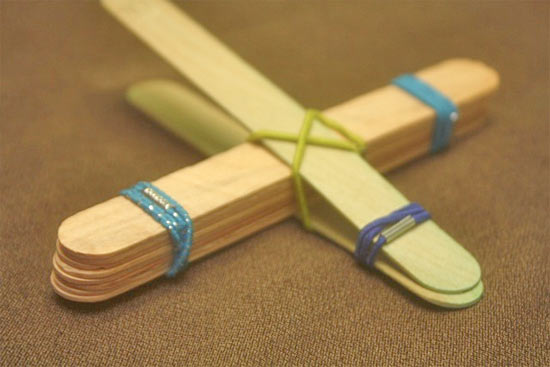1. 9 Popsicle sticks
2. 5 rubber bands
3. A projectile of your choice
How to make it:
1. Stack four Popsicle sticks. Using a rubber band at each end, squeeze the bundle tightly together.
2. Place the remaining two Popsicle sticks together. Bundle only one end together using an additional rubber band.
3. Pry the un-bundled end open enough to be able to slide the set of four sticks in between perpendicularly to form a cross. Slide the bundle of four sticks down as closely as you can get it to the rubber band that’s holding the two sticks together.
4. Finish your catapult by securing the body to the wings (diagonally at the point where the Popsicle sticks intersect) by crisscrossing a rubber band from the back of the right wing to the front of the left several times. Repeat with the final rubber band.
5. Place your projectile at the end of the Popsicle stick that is highest in the air. Hold the set of four sticks with one hand, and push down on the angled stick just behind the projectile.
6. Release your projectile!
Whats going on:
A lever is a simple machine that uses a beam attached to a pivoting hinge, or fulcrum, to amplify the amount of force applied to one end. The lever provides mechanical advantage, or leverage, to make it easier to perform work on the other end.
Catapults were used in warfare for centuries, and are a great example of the power of a lever in action. By affixing a popsicle stick at a right angle (T-shape) to another, you are effectively using the bottom one as the fulcrum for the top. By adding force to change the shape of the bow or popsicle stick from its original resting position, you add stored (potential) energy to the wood. By stacking the
popsicle sticks to increase the height of the fulcrum, then moving the end of the lever higher in the air (longer lever), you allow for more distance for the lever to build more potential energy as you pull it down. When you release your catapult, you’re quickly transferring that stored potential energy into kinetic energy that sends your projectile flying.
Whats going on:
A lever is a simple machine that uses a beam attached to a pivoting hinge, or fulcrum, to amplify the amount of force applied to one end. The lever provides mechanical advantage, or leverage, to make it easier to perform work on the other end.
Catapults were used in warfare for centuries, and are a great example of the power of a lever in action. By affixing a popsicle stick at a right angle (T-shape) to another, you are effectively using the bottom one as the fulcrum for the top. By adding force to change the shape of the bow or popsicle stick from its original resting position, you add stored (potential) energy to the wood. By stacking the
popsicle sticks to increase the height of the fulcrum, then moving the end of the lever higher in the air (longer lever), you allow for more distance for the lever to build more potential energy as you pull it down. When you release your catapult, you’re quickly transferring that stored potential energy into kinetic energy that sends your projectile flying.

No comments:
Post a Comment